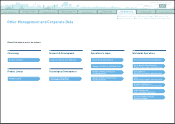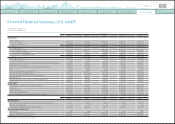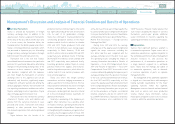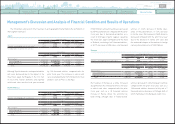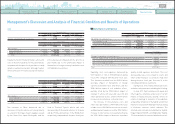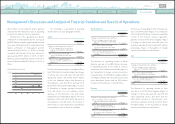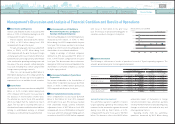Toyota 2012 Annual Report Download - page 50
Download and view the complete annual report
Please find page 50 of the 2012 Toyota annual report below. You can navigate through the pages in the report by either clicking on the pages listed below, or by using the keyword search tool below to find specific information within the annual report.
TOYOTA ANNUAL REPORT 2012
Toyota Global Vision Changes for Making
Ever-Better Cars President
ʼ
s Message Medium- to Long-Term
Growth Initiatives Special Feature Management and
Corporate Information Investor Information
Business and
Performance Review Financial Section
Management's Discussion and Analysis of Financial Condition and Results of Operations
impact the profitability of Toyota
ʼ
s automotive
operations. These laws, regulations and policies
include those attributed to environmental matters,
vehicle safety, fuel economy and emissions that
can add significantly to the cost of vehicles.
The European Union has enforced a directive
that requires manufacturers to be financially
responsible for taking back end-of-life vehicles
and to take measures to ensure that adequate
used vehicle disposal facilities are established and
those hazardous materials and recyclable parts
are removed from vehicles prior to scrapping.
See
“
Legislation Regarding End-of-Life Vehicles
”
,
“
Information on the Company
—
Business Overview
—
Governmental Regulation, Environmental and
Safety Standards
”
in Toyota
ʼ
s annual report on
Form 20-F and note 23 to the consolidated financial
statements for a more detailed discussion of these
laws, regulations and policies.
Many governments also regulate local content,
impose tariffs and other trade barriers, and enact
price or exchange controls that can limit an
automaker
ʼ
s operations and can make the
repatriation of profits unpredictable. Changes
in these laws, regulations, policies and other
governmental actions may affect the production,
licensing, distribution or sale of Toyota
ʼ
s
products, cost of products or applicable tax
rates. In February 2003, Toyota was named as
one of the defendants in purported national
class actions alleging violations of the U.S.
Sherman Antitrust Act. Toyota believes that
its actions have been lawful. In order to avoid
the competitive environment in which Toyota
operates is likely to intensify. Toyota believes it
has the resources, strategies and technologies in
place to compete effectively in the industry as an
independent company for the foreseeable future.
The competition of worldwide automobile
financial services industry is intensifying despite
the recovery trend in the automotive markets.
As competition increases, margins on financing
transactions may decrease and market share
may also decline as customers obtain financing
for Toyota vehicles from alternative sources.
Toyota
ʼ
s financial services operations mainly
include loans and leasing programs for customers
and dealers. Toyota believes that its ability to
provide financing to its customers is an important
value added service. Therefore, Toyota has
expanded its network of finance subsidiaries in
order to offer financial services in many countries.
Toyota
ʼ
s competitors for retail financing and
retail leasing include commercial banks, credit
unions and other finance companies. Meanwhile,
commercial banks and other captive automobile
finance companies also compete against Toyota
ʼ
s
wholesale financing activities.
Although Toyota
ʼ
s total finance receivables,
net was affected by the unfavorable impact
of fluctuations in foreign currency translation
rates, the total finance receivables, net increased
during fiscal 2012 mainly due to an decrease in
allowance for credit losses.
those offered by other manufacturers. The timely
introduction of new or redesigned vehicles is also
an important factor in satisfying customer needs.
Toyota
ʼ
s ability to satisfy changing customer
preferences can affect its revenues and earnings
significantly.
The profitability of Toyota
ʼ
s automotive
operations is affected by many factors. These
factors include:
• vehicle unit sales volumes,
• the mix of vehicle models and options sold,
• the level of parts and service sales,
• the levels of price discounts and other sales
incentives and marketing costs,
• the cost of customer warranty claims and
other customer satisfaction actions,
• the cost of research and development and
other fixed costs,
• the prices of raw materials,
• the ability to control costs,
• the efficient use of production capacity,
• the adverse effect on production due to
the reliance on various suppliers for the
provision of supplies,
• the adverse effect on market, sales and
productions of natural calamities and
interruptions of social infrastructure, and
• changes in the value of the Japanese yen
and other currencies in which Toyota
conducts business.
Changes in laws, regulations, policies and
other governmental actions can also materially
a protracted dispute, however, Toyota entered
into a settlement agreement with the plaintiffs
at the end of February 2006. The federal court
approved the settlement agreement, and all
related actions were dismissed. From time-to-
time when potential safety problems arise,
Toyota issues vehicle recalls and takes other
safety measures including safety campaigns
with respect to its vehicles. In November 2009,
Toyota announced a safety campaign in North
America for certain models of Toyota and Lexus
brands
ʼ
vehicles related to floor mat entrapment
of accelerator pedals, and later expanded it to
include additional models. In January 2010, Toyota
announced a recall in North America for certain
models of Toyota vehicles related to sticking
and slow-to-return accelerator pedals. Also
in January 2010, Toyota recalled in Europe and
China certain models of Toyota vehicles related
to sticking accelerator pedals. In February 2010,
Toyota announced a recall in markets including
Japan, North America and Europe related to
the braking control system in certain vehicle
models including the Prius. The recalls and
other safety measures described above have led
to a number of claims, lawsuits and government
investigations against Toyota in the United States.
For a more detailed description of these claims,
lawsuits and government investigations, see note
23 to the consolidated financial statements.
The worldwide automotive industry is in a
period of global competition which may continue
for the foreseeable future, and in general
■
Financial Services Operations
0820
Search NextPrev page 50
Contents




